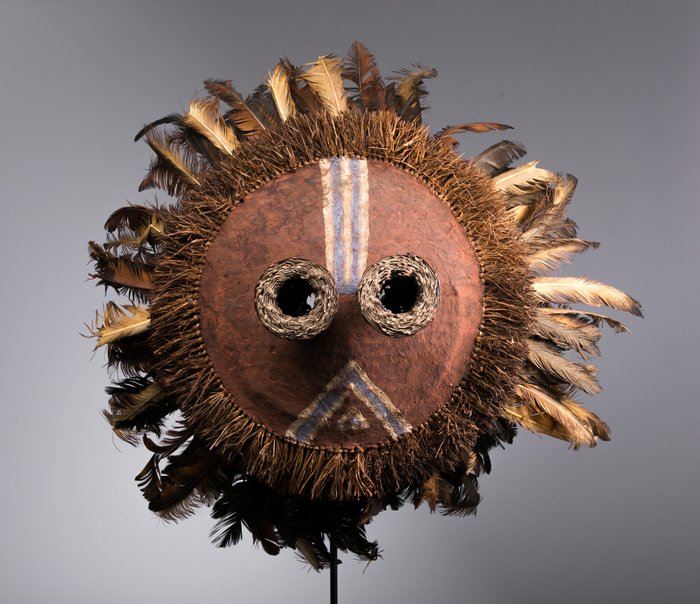编号 22002243

Minganji dance mask - Gitenga / Tundu - Pende - R. D. Congo
编号 22002243

Minganji dance mask - Gitenga / Tundu - Pende - R. D. Congo
Dimensions: diameter +/- 41 cm without the feathers.
Provenance: Former private C. De Meue collection of African art, Belgium.
Ownership: L&Z Arts Gallery.
Estimated de: around 1940.
Materials: fibres, feathers.
Sold with a certificate of authenticity.
The piece can be viewed, upon appointment, during the auction.
Secured shipment or withdrawal at the gallery.
Every people whatsoever has a certain cultural and historical background inherited from the ancestors. This culture, which forms a richness of great value, is essentially the bond of the entire social life.
This focus has led us to undertake a little
hermeneutic of the Pende masks, especially the Gitenga and the dance which is the place of their display.
There is no need to remind how dancing generally plays a great role, in all times, thanks to its ability to bring people together and to arouse joy, as well as the desire to live together in society.
This sum of harmonics made and still makes all of the peoples vibrate, but the Pende in particular, because instead of gathering only men and women, or facing a musician, a well-known artist, the Pende marvellously knew how to diversify their dancing style, also by including masked persons among the crowd who performed a very original dance accompanied by everyone. The dance of the mask is different than the one of an ordinary man. In fact, the dance of the minganji masks was not unexpected, it was performed in a very specific way and on the occasion of precise circumstances.
There are many occasions during which the minganji can be exhibited. We will only retain four.
1 - Traditionally, the first circumstance is established by the
elders during the days following the definitive closing of the initiation session of young people who, from then, will be considered as adults. This initiation is named “mukanda”. On this occasion, the minganji dance in order to mark the welcoming of young initiates within adulthood.
2 - The second representation may be done in favour of the sick persons, struck by a curse (hamba) which is nothing other than the punishment from the spirits of the forest when a person infringed the interdicts of the mukanda.
3 - The enthronement or the death of a chief (fumu ya dimbo).
4 - The most ordinary and frequent representation is the one performed for popular rejoicing. It can take place during great festivities or it can be performed to warm up, revive a village that would have suffered a mourning, or even to help a population to overcome monotony of life.
Please note that the Gitenga is the equivalent of the Tundu for the mbuya masks. Gitenga is the mask which creates many shows thanks to its multiple gestures and comedies. Once the exhibition over, it can remain in the surroundings and give way to the other masks. However, in certain moments it can still appear on stage and provoke other masks.
The Christian De Meue collection of African art.
Christian De Meue owns a little gallery for years. The beginnings of the De Meue collection date back to the 1960s; the father, Lucien De Meue, an artist-painter and restorer of famous paintings, lived in the surroundings of the avenue Louise, since the 1950s, in Brussels. At the time he owned a few pieces of tribal art, inherited by Christian at a later stage. The latter, who also became restorer of paintings and studied at the Academy of Fine Arts (Académie des Beaux-Arts) in Brussels, interacted with gallery owners who are now renowned, like Marc Léo Felix. He travelled around the world and then progressively increased his collector’s appetite. Thus, Christian travelled with his entire collection, while completing it (between 300 and 400 pieces). He ended up by definitively settling in Zelzate, since the early 2000s. Christian claims to be, first and foremost, a collector and not a merchant.
